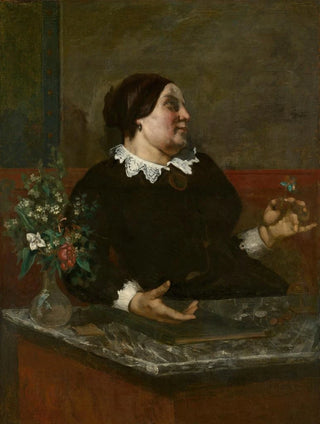Art print | Mme Grégoire - Gustave Courbet


View from behind

Frame (optional)
In the vast panorama of art history, some works stand out for their ability to capture the very essence of humanity. "Mme Grégoire" by Gustave Courbet is one of those iconic creations that transcend time and styles. Created in the 19th century, this painting does more than depict a portrait; it evokes psychological depth and intimacy that invite the viewer to delve into the inner universe of its subject. The figure of Mme Grégoire, with her penetrating gaze and delicate posture, thus becomes a reflection of a rapidly changing era, where art liberates itself from academic conventions to embrace a more personal and realistic approach.
Style and uniqueness of the work
The work "Mme Grégoire" is distinguished by its realistic style, characteristic of Courbet. The artist, a pioneer of realism, chooses to paint ordinary subjects, far from classical ideals. In this portrait, the texture of the skin, the nuances of clothing, and the subtle lighting demonstrate a meticulous attention to detail that gives the composition an almost tactile atmosphere. The colors, both soft and vibrant, create a harmonious balance, while the neutral background highlights the figure of Mme Grégoire. Courbet manages to capture not only the physical appearance of his model but also a certain fragility, a palpable humanity that touches the heart. This innovative approach, far from beauty stereotypes imposed by tradition, makes this work a true artistic manifesto.
The artist and his influence
Gustave Courbet, a major figure of the realist movement, not only redefined the standards of painting but also influenced generations of artists. His commitment to faithful representation of reality, often tinged with social critique, paved the way for new artistic currents, notably Impressionism. Courbet firmly believed that art should be rooted in the reality of the world, far from romantic fantasies. Through works like "Mme Grégoire," he invites the viewer to contemplate the human condition, to question identity and perception. His legacy endures,

Matte finish

View from behind

Frame (optional)
In the vast panorama of art history, some works stand out for their ability to capture the very essence of humanity. "Mme Grégoire" by Gustave Courbet is one of those iconic creations that transcend time and styles. Created in the 19th century, this painting does more than depict a portrait; it evokes psychological depth and intimacy that invite the viewer to delve into the inner universe of its subject. The figure of Mme Grégoire, with her penetrating gaze and delicate posture, thus becomes a reflection of a rapidly changing era, where art liberates itself from academic conventions to embrace a more personal and realistic approach.
Style and uniqueness of the work
The work "Mme Grégoire" is distinguished by its realistic style, characteristic of Courbet. The artist, a pioneer of realism, chooses to paint ordinary subjects, far from classical ideals. In this portrait, the texture of the skin, the nuances of clothing, and the subtle lighting demonstrate a meticulous attention to detail that gives the composition an almost tactile atmosphere. The colors, both soft and vibrant, create a harmonious balance, while the neutral background highlights the figure of Mme Grégoire. Courbet manages to capture not only the physical appearance of his model but also a certain fragility, a palpable humanity that touches the heart. This innovative approach, far from beauty stereotypes imposed by tradition, makes this work a true artistic manifesto.
The artist and his influence
Gustave Courbet, a major figure of the realist movement, not only redefined the standards of painting but also influenced generations of artists. His commitment to faithful representation of reality, often tinged with social critique, paved the way for new artistic currents, notably Impressionism. Courbet firmly believed that art should be rooted in the reality of the world, far from romantic fantasies. Through works like "Mme Grégoire," he invites the viewer to contemplate the human condition, to question identity and perception. His legacy endures,






